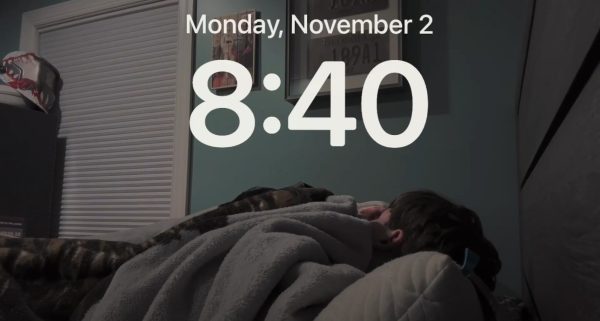Our Opinion: Where do we go from here?
December 1, 2017
Earlier this semester, an incident involving an armed student on campus shook Marywood University. The best-case scenario played out. Nobody was harmed and no shots were fired by the suspect or authorities.
So, where do we go from here?
The Wood Word Editorial Board commends Marywood’s administration, Campus Safety and the local authorities for responding quickly and minimizing the threat in October without any further incident. Looking back, being prepared and preventing panic should be top priority going forward.
In an interview with The Wood Word, Marywood President Sr. Mary Persico, IHM, Ed.D said a task force is reviewing all of the university’s emergency policies, and the recent incident is being analyzed.
With that in mind, here are a number of steps The Wood Word Editorial Board would like to see implemented at Marywood for emergency situations.
- Comprehensive Crisis Management Plans should be updated and Contingency Plans should be created
According to current Marywood policy, a chain of command dictates the communication between different levels:
“The Chief of Campus Safety or his/her designee will notify the Senior Director of Safety, Security and Environmental Compliance, Director of Physical Plant, Assistant Vice President for Marketing and Communications, Dean of Students, Director of Housing and Residence Life, and Director of Buildings and Grounds. The Senior Director of Safety, Security and Environmental Compliance will notify the Vice President for Business Affairs and Treasurer. The Vice President for Business Affairs and Treasurer will notify the President of the University, the Vice President for Academic Affairs and other members of the President’s Cabinet.”
Separate from the policy mentioned above, Marywood’s detailed emergency response plan is available on the MarywoodYou Portal for those with a Marywood account to view. It does outline a response team and plan. The plan includes how the response team is supposed to deal with emergencies in each building and how to carry out communication during and after an emergency event.
An emergency won’t always happen when everyone involved in the response team is available, or when the plan can be carried out exactly as written. Detailed contingency plans should be in place for when an emergency can’t be handled in accordance with the primary plan.
In addition to the communication chain of command and the primary emergency response team, additional personnel and a contingency response team should be prepared for the event that the next in line is not on campus or immediately available. The crisis policy should indicate that everyone on the response team and chain of command has someone else who can step in as backup. This creates a secondary response team and extra personnel that act as insurance in the case that any primary response team members are unavailable.
The chain of command shows who reports to whom while the response team is a separate list of those individuals prepared to act in an emergency situation. These lists should not be seen as backups for one another, because they detail different aspects of the crisis plan: communication and action. A possible update is to merge the chain of command with the response team and do away with any separate mentions of the two. Regardless of the decision to merge them or not, both of these aspects should have backups in place.
According to Marywood’s policy only the Chief of Campus Safety and the Dean of Students have the authority to activate the emergency alert system; only the Chief of Campus Safety or the Dean of Students can give further instructions via the system; and only an authorized member of the President’s Cabinet can give the all-clear when a threat is minimized. But in the instance that these people are not available, the proposed backup personnel in the chain of command will ensure that no matter what, there will be a proper emergency alert.
- Transparency should be a priority whenever possible
Recently, Marywood administrators sent out an email about an update to campus policy on procedures involving child abuse and the knowledge of such issues. In late November, an email was sent to students with an update on Marywood’s policy regarding Title IX and sexual assault cases. Any new policies concerning on-campus crises and any procedures that should be followed would be best shared in a similar fashion. Sadly, tragic incidents are becoming very commonplace, so being prepared for them is important and transparency is an important part of preparedness.
- Clear and ongoing communication processes should be evaluated
Ensuring that at least one Campus Safety officer or member of the crisis management response team on duty has the authority to send out an alert and is ready to do so would minimize confusion.
This communication should not be once and done, either. If a threat is ongoing, the community needs to be informed in an ongoing way. Without updates, no one will know if the threat is still present or if everyone is safe again.
- Training for Marywood community should be enacted
It’s one thing if the administration or Campus Safety know how to respond in a crisis situation, but what about faculty, staff and students?
Marywood can implement mandatory training of some level for students to complete within their first year here, and for anyone employed by the university to complete upon hiring. There’s already an alcohol abuse training program for new students on the Student Portal, which is a source where crisis training for students could be implemented for both incoming freshmen and transfer students.
Individual threats could be different, so training all students to properly deal with each potential situation would be a difficult and impractical undertaking. But making sure students know basic procedures would reduce the chance of panic. These procedures could include how to seek the safest places to shelter within a building depending upon the type of threat and the importance of safe and calm evacuations.
One of the most important things students need to learn is to stay calm and to follow all directions from appropriate authority figures. It is also important to stress to students that they should refrain from spreading rumors or information they have heard on social media without hearing it straight from any authority figure. This goes back to clear and ongoing communication, as well. If students are being informed about what they need to do and what the threat is, they won’t be led to believe the threat is worse than it is or that it’s not being handled properly.
- Reviewing Emergency Response Plans should be an annual priority
According to the Emergency Response Plan that is available for those with MarywoodYou Portal accounts, it was last updated in February of 2011. The Portal says the document was modified in 2012.
Reviewing the plan annually would ensure that everyone involved with the plan could be reminded of their responsibilities. Continuous review and updates to any existing plans will ensure that they are always up to date with the current state of the campus.
Construction and alterations to the physical layout of the campus as well as staffing changes could affect the way that an emergency response plan could be carried out.
For example, policies like the Deadly Weapons and Fireworks Policy mention a Senior Director of Safety, Security and Environmental Compliance. A search of Marywood University’s website shows that this position either doesn’t exist anymore or is vacant. The policy needs to be updated to account for vacancies and position changes like this one.
While Marywood experienced the best-case scenario of an armed suspect, the worst-case scenario has played out too many times in recent years across the country. Crises and threats can happen at any time, and Marywood should always be prepared to respond. There is a policy in place, but there is and always will be room for improvement.
Have an Opinion? Send a Letter to the Editor!
The Wood Word reserves the right to edit letters for length and grammar. Please include your name, title, and a phone number where you can be reached.
Send to: [email protected]















